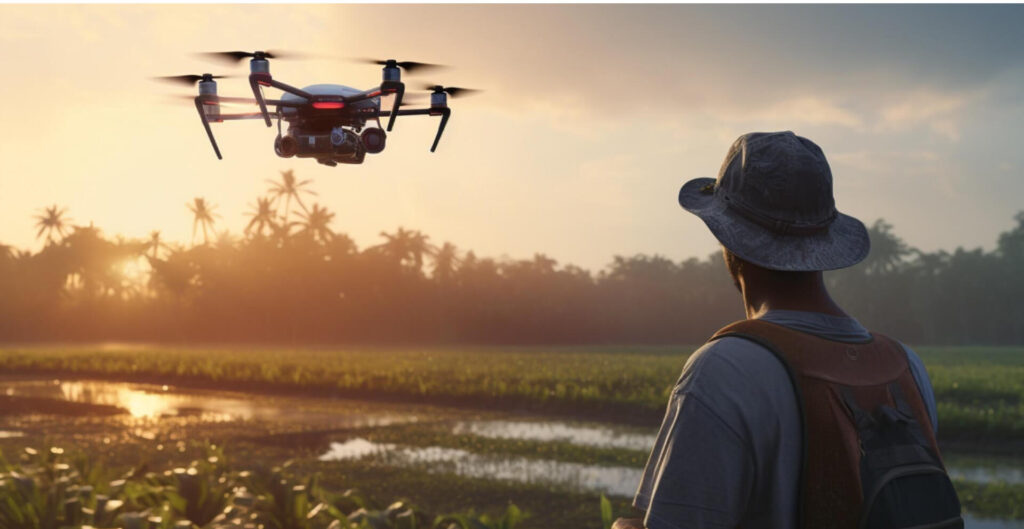
The agriculture industry is undergoing a transformative change with the integration of drone technology. Drones, or unmanned aerial vehicles (UAVs), are becoming essential tools for modern farming, offering new ways to monitor crops, manage fields, and optimize resources. Here, we explore how drones are revolutionizing farming practices and the profound impact they are having on agriculture.
1. Precision Agriculture
Crop Monitoring: Drones equipped with multispectral and hyperspectral cameras capture detailed aerial images of fields. These images help farmers monitor crop health, identify stressed plants, and detect pest infestations early. This real-time data allows for targeted interventions, ensuring healthy crops and improved yields.
Soil Analysis: By using sensors to collect data on soil moisture, composition, and temperature, drones provide valuable insights into soil health. Farmers can make informed decisions about irrigation, fertilization, and crop rotation, leading to better soil management and enhanced crop productivity.
2. Efficient Resource Management
Irrigation Management: Drones equipped with thermal sensors can detect variations in soil moisture levels across a field. This information helps farmers optimize irrigation schedules, reducing water usage and ensuring that crops receive the right amount of water at the right time.
Fertilizer and Pesticide Application: Drones can apply fertilizers, pesticides, and herbicides with high precision, targeting only the areas that need treatment. This reduces the amount of chemicals used, lowering costs and minimizing environmental impact.
3. Enhanced Crop Surveillance
Field Mapping and Analysis: Drones create high-resolution maps and 3D models of fields, providing detailed topographical information. This data helps farmers identify field variations, plan planting patterns, and manage crop rotation effectively.
Disease Detection: Drones can detect early signs of diseases in crops by analyzing changes in plant color and temperature. Early detection allows for timely treatment, preventing the spread of disease and minimizing crop loss.
4. Increased Productivity
Timely Interventions: The real-time data provided by drones allows for quick decision-making and timely interventions. Farmers can address issues such as pest infestations, nutrient deficiencies, and water stress promptly, ensuring that crops remain healthy and productive.
Yield Estimation: Drones can estimate crop yields by analyzing plant height, canopy cover, and other growth parameters. Accurate yield predictions help farmers plan harvests, manage inventory, and make informed market decisions.
5. Cost Savings
Reduced Labor Costs: Drones automate many labor-intensive tasks, such as field surveying and crop monitoring. This reduces the need for manual labor, lowering operational costs and allowing farmers to allocate resources more efficiently.
Lower Input Costs: By applying inputs such as water, fertilizers, and pesticides more precisely, drones help reduce waste and lower input costs. This improves overall farm profitability and sustainability.
6. Environmental Benefits
Sustainable Farming Practices: Precision agriculture enabled by drones promotes sustainable farming practices. By using resources more efficiently and reducing chemical usage, drones help minimize the environmental footprint of farming operations.
Conservation Efforts: Drones can monitor natural resources, track wildlife, and assess the health of ecosystems on and around farms. This supports conservation efforts and promotes biodiversity in agricultural landscapes.
7. Future Prospects
Autonomous Farming: The future of agriculture may see the integration of drones with other autonomous farming equipment, such as robotic harvesters and automated tractors. This fully automated approach could revolutionize farming, making it more efficient and less labor-intensive.
Data Integration and AI: Advances in artificial intelligence and machine learning will enable drones to analyze vast amounts of data, providing deeper insights and predictive analytics. This will further enhance decision-making and optimize farming practices.
Regulatory Developments: As drone technology becomes more widespread, regulatory frameworks will continue to evolve. Clear guidelines and standards will ensure safe and effective use of drones in agriculture, promoting innovation and adoption.


